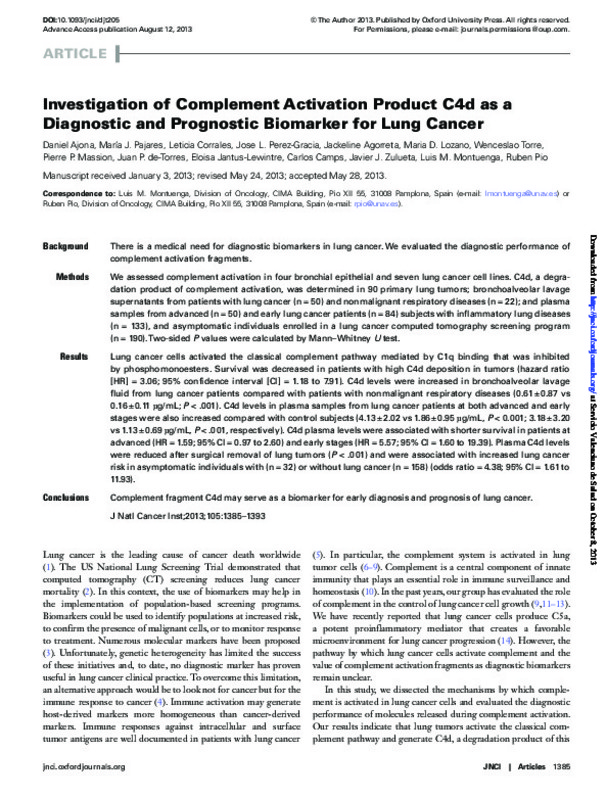|
Resumen:
|
[EN] Background There is a medical need for diagnostic biomarkers in lung cancer. We evaluated the diagnostic performance of complement activation fragments.
Methods We assessed complement activation in four bronchial ...[+]
[EN] Background There is a medical need for diagnostic biomarkers in lung cancer. We evaluated the diagnostic performance of complement activation fragments.
Methods We assessed complement activation in four bronchial epithelial and seven lung cancer cell lines. C4d, a degradation product of complement activation, was determined in 90 primary lung tumors; bronchoalveolar lavage supernatants from patients with lung cancer (n = 50) and nonmalignant respiratory diseases (n = 22); and plasma samples from advanced (n = 50) and early lung cancer patients (n = 84) subjects with inflammatory lung diseases (n = 133), and asymptomatic individuals enrolled in a lung cancer computed tomography screening program (n = 190). Two-sided P values were calculated by Mann-Whitney U test.
Results Lung cancer cells activated the classical complement pathway mediated by C1q binding that was inhibited by phosphomonoesters. Survival was decreased in patients with high C4d deposition in tumors (hazard ratio [HR] = 3.06; 95% confidence interval [CI] = 1.18 to 7.91). C4d levels were increased in bronchoalveolar lavage fluid from lung cancer patients compared with patients with nonmalignant respiratory diseases (0.61 +/- 0.87 vs 0.16 +/- 0.11 mu g/mL; P < .001). C4d levels in plasma samples from lung cancer patients at both advanced and early stages were also increased compared with control subjects (4.13 +/- 2.02 vs 1.86 +/- 0.95 mu g/mL, P < 0.001; 3.18 +/- 3.20 vs 1.13 +/- 0.69 mu g/mL, P < .001, respectively). C4d plasma levels were associated with shorter survival in patients at advanced (HR = 1.59; 95% CI = 0.97 to 2.60) and early stages (HR = 5.57; 95% CI = 1.60 to 19.39). Plasma C4d levels were reduced after surgical removal of lung tumors (P < .001) and were associated with increased lung cancer risk in asymptomatic individuals with (n = 32) or without lung cancer (n = 158) (odds ratio = 4.38; 95% CI = 1.61 to 11.93).
Conclusions Complement fragment C4d may serve as a biomarker for early diagnosis and prognosis of lung cancer.
[-]
|
|
Agradecimientos:
|
This work was supported by UTE project CIMA; the Spanish Government (grant numbers ISCIII-RTICC RD06/0020/0066, RD06/0020/1024, RD12/0036/0025, RD12/0036/0040, RD12/0036/0062, PI08/0923, PI10/01652, PI10/00166, and ...[+]
This work was supported by UTE project CIMA; the Spanish Government (grant numbers ISCIII-RTICC RD06/0020/0066, RD06/0020/1024, RD12/0036/0025, RD12/0036/0040, RD12/0036/0062, PI08/0923, PI10/01652, PI10/00166, and PI11/00618); the European Regional Development Fund; the European Community’s Seventh Framework Programme (HEALTH-F2-2010-258677- CURELUNG); and the Early Detection Research Network from the National Cancer Institute (grant number U01 CA152662). This work was supported (in part) by a grant (RD12/0036/XXXX) from Red Temática de Investigación Cooperativa en Cáncer, Instituto de Salud Carlos III, Spanish Ministry of Economy and Competitiveness & European Regional Development Fund “Una manera de hacer Europa”.
[-]
|









